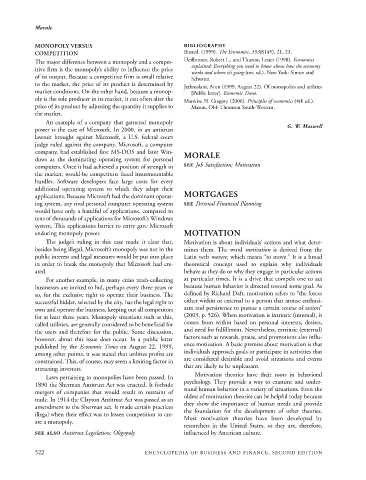Page 545 - Encyclopedia of Business and Finance
P. 545
eobf_M 7/5/06 3:15 PM Page 522
Morale
MONOPOLY VERSUS BIBLIOGRAPHY
COMPETITION Busted. (1999). The Economist, 353(8145), 21, 23.
The major difference between a monopoly and a compet- Heilbroner, Robert L., and Thurow, Lester (1998). Economics
explained: Everything you need to know about how the economy
itive firm is the monopoly’s ability to influence the price
works and where it’s going (rev. ed.). New York: Simon and
of its output. Because a competitive firm is small relative Schuster.
to the market, the price of its product is determined by
Jethmalani, Arun (1999, August 22). Of monopolies and utilities
market conditions. On the other hand, because a monop- [Public letter]. Economic Times.
oly is the sole producer in its market, it can often alter the Mankiw, N. Gregory (2006). Principles of economics (4th ed.).
price of its product by adjusting the quantity it supplies to Mason, OH: Thomson South-Western.
the market.
An example of a company that garnered monopoly
G. W. Maxwell
power is the case of Microsoft. In 2000, in an antitrust
lawsuit brought against Microsoft, a U.S. federal court
judge ruled against the company. Microsoft, a computer
company, had established first MS-DOS and later Win- MORALE
dows as the dominating operating system for personal
computers. Once it had achieved a position of strength in SEE Job Satisfaction; Motivation
the market, would-be competitors faced insurmountable
hurdles. Software developers face large costs for every
additional operating system to which they adapt their
applications. Because Microsoft had the dominant operat- MORTGAGES
ing system, any rival personal computer operating system SEE Personal Financial Planning
would have only a handful of applications, compared to
tens of thousands of applications for Microsoft’s Windows
system. This applications barrier to entry gave Microsoft
enduring monopoly power. MOTIVATION
The judge’s ruling in this case made it clear that, Motivation is about individuals’ actions and what deter-
besides being illegal, Microsoft’s monopoly was not in the mines them. The word motivation is derived from the
public interest and legal measures would be put into place Latin verb movere, which means “to move.” It is a broad
in order to break the monopoly that Microsoft had cre- theoretical concept used to explain why individuals
ated. behave as they do or why they engage in particular actions
For another example, in many cities trash-collecting at particular times. It is a drive that compels one to act
businesses are invited to bid, perhaps every three years or because human behavior is directed toward some goal. As
so, for the exclusive right to operate their business. The defined by Richard Daft, motivation refers to “the forces
successful bidder, selected by the city, has the legal right to either within or external to a person that arouse enthusi-
own and operate the business, keeping out all competitors asm and persistence to pursue a certain course of action”
for at least three years. Monopoly situations such as this, (2003, p. 526). When motivation is intrinsic (internal), it
called utilities, are generally considered to be beneficial for comes from within based on personal interests, desires,
the users and therefore for the public. Some discussion, and need for fulfillment. Nevertheless, extrinsic (external)
however, about this issue does occur. In a public letter factors such as rewards, praise, and promotions also influ-
ence motivation. A basic premise about motivation is that
published by the Economic Times on August 22, 1999,
individuals approach goals or participate in activities that
among other points, it was stated that utilities profits are
are considered desirable and avoid situations and events
constrained. This, of course, may seem a limiting factor in
that are likely to be unpleasant.
attracting investors.
Motivation theories have their roots in behavioral
Laws pertaining to monopolies have been passed. In
psychology. They provide a way to examine and under-
1890 the Sherman Antitrust Act was enacted. It forbade
stand human behavior in a variety of situations. Even the
mergers of companies that would result in restraint of
oldest of motivation theories can be helpful today because
trade. In 1914 the Clayton Antitrust Act was passed as an
they show the importance of human needs and provide
amendment to the Sherman act. It made certain practices
illegal when their effect was to lessen competition to cre- the foundation for the development of other theories.
Most motivation theories have been developed by
ate a monopoly.
researchers in the United States, so they are, therefore,
SEE ALSO Antitrust Legislation; Oligopoly influenced by American culture.
522 ENCYCLOPEDIA OF BUSINESS AND FINANCE, SECOND EDITION

